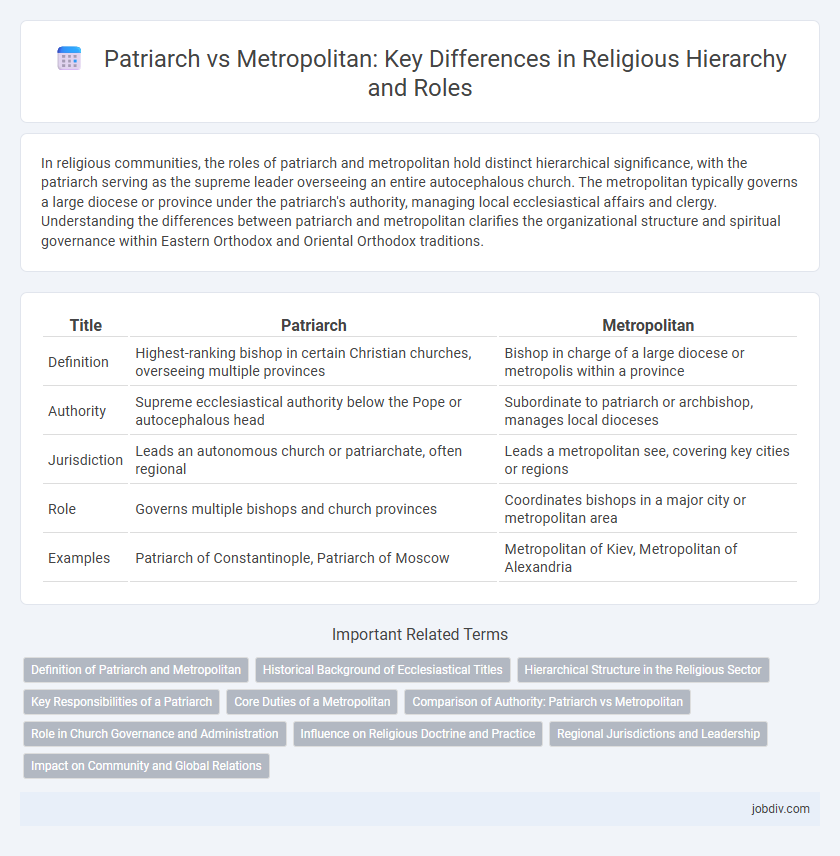In religious communities, the roles of patriarch and metropolitan hold distinct hierarchical significance, with the patriarch serving as the supreme leader overseeing an entire autocephalous church. The metropolitan typically governs a large diocese or province under the patriarch's authority, managing local ecclesiastical affairs and clergy. Understanding the differences between patriarch and metropolitan clarifies the organizational structure and spiritual governance within Eastern Orthodox and Oriental Orthodox traditions.
Table of Comparison
| Title | Patriarch | Metropolitan |
|---|---|---|
| Definition | Highest-ranking bishop in certain Christian churches, overseeing multiple provinces | Bishop in charge of a large diocese or metropolis within a province |
| Authority | Supreme ecclesiastical authority below the Pope or autocephalous head | Subordinate to patriarch or archbishop, manages local dioceses |
| Jurisdiction | Leads an autonomous church or patriarchate, often regional | Leads a metropolitan see, covering key cities or regions |
| Role | Governs multiple bishops and church provinces | Coordinates bishops in a major city or metropolitan area |
| Examples | Patriarch of Constantinople, Patriarch of Moscow | Metropolitan of Kiev, Metropolitan of Alexandria |
Definition of Patriarch and Metropolitan
A Patriarch is a senior bishop who holds authority over a major Christian church or a specific geographical region, often considered the highest-ranking bishop within Eastern Orthodox, Oriental Orthodox, and some Eastern Catholic Churches. A Metropolitan is a bishop responsible for an ecclesiastical province or a large city, overseeing other bishops within that jurisdiction but ranking below a Patriarch. The distinction between the two centers on hierarchical authority, with the Patriarch having broader spiritual and administrative control compared to the Metropolitan's regional oversight.
Historical Background of Ecclesiastical Titles
The historical background of ecclesiastical titles reveals that the title of Patriarch emerged in early Christianity as a designation for bishops who held authority over major regions, particularly in important cities like Rome, Constantinople, Alexandria, Antioch, and Jerusalem. The title of Metropolitan evolved to signify bishops overseeing significant ecclesiastical provinces, operating under the jurisdiction of a Patriarch or directly under the authority of a Major Archbishop in Eastern traditions. These hierarchical distinctions reflect the development of church governance and the consolidation of regional religious authority from the first centuries through the Byzantine period.
Hierarchical Structure in the Religious Sector
The hierarchical structure in the religious sector distinguishes a patriarch as the highest-ranking bishop, often overseeing multiple metropolitan regions within an autocephalous or autonomous church. Metropolitans serve as senior bishops responsible for managing individual ecclesiastical provinces, reporting directly to the patriarch. This layered governance ensures a structured delegation of spiritual authority and administrative responsibilities across the church organization.
Key Responsibilities of a Patriarch
A Patriarch holds the highest ecclesiastical authority in certain Christian traditions, overseeing the spiritual and administrative needs of an entire autocephalous church. His key responsibilities include presiding over synods, defining doctrinal positions, and maintaining unity among bishops and the faithful. The Patriarch also represents the church in ecumenical relations and ensures adherence to canonical laws across his jurisdiction.
Core Duties of a Metropolitan
A Metropolitan primarily oversees multiple dioceses within a province, providing spiritual leadership, administrative supervision, and ensuring doctrinal unity among the bishops under his jurisdiction. He convenes provincial synods to address ecclesiastical matters, enforces church canon law, and represents the church in broader religious or interfaith dialogues. Unlike a Patriarch, whose authority extends over an entire autocephalous church, a Metropolitan's core duties focus on regional governance and maintaining harmony between local bishops and the patriarchate.
Comparison of Authority: Patriarch vs Metropolitan
The patriarch holds the highest ecclesiastical authority within an autocephalous Orthodox Church, often overseeing multiple metropolitan bishops and maintaining ultimate decision-making power in doctrinal and administrative matters. In contrast, a metropolitan governs a major ecclesiastical province or metropolis under the patriarch's jurisdiction, exercising significant but subordinate authority over local bishops and church affairs. The patriarch's role encompasses a broader, church-wide spiritual and administrative leadership, while the metropolitan's authority is geographically limited and focused on regional church governance.
Role in Church Governance and Administration
A patriarch serves as the highest-ranking bishop and spiritual leader in certain Eastern Orthodox, Oriental Orthodox, and Eastern Catholic Churches, overseeing multiple metropolitans and dioceses. A metropolitan functions as a senior bishop responsible for a major city or region within a patriarchate, exercising authority over bishops in that area while reporting to the patriarch. The patriarch holds ultimate administrative authority, including convening councils and defining doctrine, whereas the metropolitan manages regional church governance and implements directives from the patriarch.
Influence on Religious Doctrine and Practice
Patriarchs traditionally hold supreme authority in shaping religious doctrine, often defining dogmatic teachings that influence large, national or ethnic church bodies. Metropolitans exercise significant influence within their metropolitan provinces, overseeing bishops and ensuring adherence to established doctrines and liturgical practices. The patriarch's pronouncements typically carry wider canonical weight, while metropolitans adapt and implement these directives, balancing centralized theology with regional ecclesiastical tradition.
Regional Jurisdictions and Leadership
Patriarchs hold supreme authority over entire autocephalous or autonomous churches, often spanning multiple countries or regions, while metropolitans govern smaller, defined regional jurisdictions within those churches. Patriarchal leadership embodies the highest ecclesiastical rank, responsible for guiding major theological, administrative, and liturgical decisions across vast territorial boundaries. Metropolitans exercise direct oversight within their dioceses or provinces, facilitating localized governance and maintaining unity under the patriarch's overarching spiritual jurisdiction.
Impact on Community and Global Relations
Patriarchs, as supreme heads of autocephalous Orthodox Churches, wield considerable influence on community cohesion and global religious diplomacy, fostering unity among diverse Orthodox faithful. Metropolitans, overseeing significant regional jurisdictions, directly impact local communities by addressing spiritual needs and facilitating inter-diocesan cooperation, which strengthens grassroots ecclesiastical structures. The interplay between patriarchal authority and metropolitan leadership shapes both localized religious experiences and broader interfaith dialogues, enhancing the Orthodox Church's role in international religious relations.
patriarch vs metropolitan Infographic

 jobdiv.com
jobdiv.com